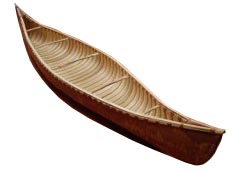
Preparing Roots for Lashings
This article will outline the process for preparing roots to make lashings. Before nails came into use late in the
19th century, Native builders used root lashings to bind canoes together. Previous articles outlined other canoe-making
processes: Selecting a canoe to model; reducing its dimensions to one-quarter scale; making a "blueprint" of the canoe;
constructing a reusable building platform; making a gunwale frame; making and installing thwarts; making ribs, splitting
cedar and making sheathing. To review previous articles, go to www.barkcanoe.com/home.htm. Then select "Tips" and sort
through past issues of "The Bark Canoe Aficionado."
Future articles will focus on assembling the components of the canoe: the gunwales, gunwale frame, root lashings, thwarts,
ribs, sheathing, etc. Preparing these skeletal elements constitutes at least 50 percent of the work of building any canoe.
The assembly process takes the other 50 percent of the building time. Each component of the canoe can be made separately,
at any time and in any sequence, then stored until you are ready for assembly. It should also be noted that all of the
procedures outlined in these articles are identical to those for making full size canoes. Required tools for preparing
roots: Digging tools, a general-purpose knife and a razor knife.
Many different kinds of roots are suitable for canoe building. Among them are Black Spruce (Picea Mariana), Red Spruce
(Picea Rubens), Tamarack (Larix Laricini), and Jack Pine (Pinus Banksiana). Gathering roots is my least favorite job in
]building a canoe. It is hot, buggy and dirty work. Since it is unpleasant, gather more roots than you need so you won't
have to do it again anytime soon. For model making you want roots that are about the thickness of a wooden matchstick.
Get the longest lengths you can find.
Boil the roots for a minimum of 30 minutes in a large pot or kettle. When cooled, trim any small rootlets or branches
from the roots. Peel the bark off by rapidly running an angled knife blade along the length of the root. This may take
several passes, but the bark will eventually peel away, leaving a smooth, clean root. Split the root, using the roots
natural "center line" as a guide. Then split each remaining half again to remove the woody center. The same splitting
technique is used for cedar, spruce roots or for any other wood. Apply equal pressure to both sides of the split, but if
the split wanders to one side or another, apply slightly more pressure in the direction that you want the split to go.
A little practice will give you the skill you need to process lots of root. For really small roots, the second split may
not be necessary since the woody center may not have yet developed. The finished "product" should be a thin and straight
root, with one flat surface and one rounded surface.
For quarter-scale models, roots must be no larger than 3/32" wide. Carefully measure and trim one perfect root to see what
a root of that size looks like when prepared correctly. Use that mental image to trim other roots to the same approximate
size. You'll be surprised at how well you can "eye-ball" the correct dimensions with a little practice.
Coil the trimmed roots and store in a cool, dry place until ready for use. Then, soak them in warm water for an hour or
so to restore their original flexibility. While doing lashings, keep the roots ready for use in fresh water. Between
work sessions, let the roots dry out again. Keeping them constantly in water, encourages bacterial growth which turns the
creamy color of the roots to black.
Next, turn your attention to rolling out and setting up the bark on the building platform. That process will be described
in next month's newsletter.
Next Page
509-327-7902 voice and fax barkcanoe@earthlink.net e-mail
Home Canoes Classes Materials Accessories News and Stuff Links Consignment Canoes